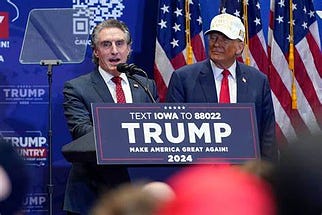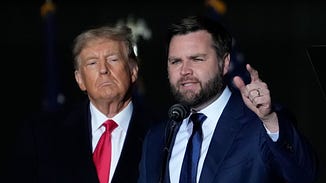Al Hunt: Trump’s VP pick: much ado about little
The political calendar will be filled this month with speculation about Donald Trump’s choice of a running mate.
It doesn’t much matter unless he’s elected and dies in office.
I have no idea who he’ll pick, as I suspect hardly anyone else does. There are three potential attributes a Vice-Presidential candidate can bring: help carry a state or region, create an uplifting vibe to the ticket and, if successful, be an important governing partner.Unlike 2016 when he first ran, almost every voter today has strong feelings about Trump; he’s a hero to supporters, and most detractors hate him. These feelings are so strong- they’re unlikely to be much affected by his running mate.
Eight years ago, the choice of Indiana Gov. Mike Pence arguably helped the thrice-married, vulgar braggard with evangelicals. I suspect that with the animosity these folks felt toward Hillary Clinton, the threat they imagined from secularists and the fate of abortion, they would have swallowed any reservations and voted for Trump anyway.
Over the past half century, there have been some first-rate Vice-Presidential choices- Republicans and Democrats alike. But none delivered a state that the Presidential nominee wouldn’t have carried anyway. The last time that happened was Democrat Lyndon Johnson and Texas in 1960.
Almost three decades later, another Vice-Presidential choice, Texas Democrat, Sen. Lloyd Bentsen was considered a much better choice than Republican Dan Quayle. It didn’t matter; the Republicans handily carried the election and Texas.
Today, the half dozen most mentioned names — Senators J.D. Vance of Ohio, Marco Rubio of Florida, South Carolina’s Tim Scott, Arkansas’ Tom Cotton, New York Representative Elise Stefanik and North Dakota Gov. Doug Burgum — all once Trump critics — now are fawning sycophants.
No matter the choice, Trump would carry all those states except New York. There is a constitutional impediment for both members of the ticket being from the same state; if Trump asked Rubio to move, the response would be how far?
Some Republicans, especially business executives, want a reassuring choice. Seriously? The reason the charismatically challenged Burgum, a billionaire, is on any list, is not his business expertise, but his deep pockets. I recall a 2016 Christmas party in Vail where wealthy business executives expressed confidence that Trump would be the political face of the new administration; Pence would lead governance.
As for age, if elected at 78, Trump would be the second oldest U.S. President, older than Biden was when he took office. But the age issue is dominated by Biden.
Vice Presidential choices have complemented the nominee. George H.W. Bush under Ronald Reagan, Dick Cheney with George W. Bush and Biden under Barack Obama all brought Washington and foreign policy experience that the top man lacked.
In 1992, Al Gore, running with Bill Clinton, presented an appealing package: generational change with two young, exceptionally bright moderate Southerners.
They all filled the governing mandate. That contemporary role was established in the 1970s by Walter Mondale, Vice President under Jimmy Carter. The “Mondale model” was a close working partnership between the President and Vice President with total access.
That’s anathema to Trump, says Richard Moe, who as the Vice President’s chief of staff helped draft the Mondale model. “It has worked for almost every Administration except Trump,” says Moe. “He doesn’t want a Vice President with any independent expertise; he only wants total devotion to him.”
Does anyone really think that a J.D. Vance would be a partner on foreign policy OR Tim Scott on domestic issues? In the Trump administration, Mike Pence played a singularly effective role in promoting an anti-abortion agenda and early on a few cabinet members played an outsized role. Trump believes he now knows how to mold the government and won’t have to rely on people like that.
As he makes his choice, it’s worth remembering the exercise eight years ago. Trump asked Pence to be his running mate; the next day, he told New Jersey Gov. Chris Christie he might turn to him. He flirted with picking former House Speaker Newt Gingrich until, according to a report in Politico, Trump told an adviser that during the vetting process the dirt dug up on Gingrich “makes mine look tame.”
There is the matter of perspective. In 1976 President Gerald Ford picked Bob Dole as his running mate and lost. Later, Rod Slifer, a good friend, suggested that he might have won if he had picked someone like Bill Ruckelshaus, an environmentalist and former Deputy Attorney General. Nonsense, replied Ford, people don’t vote for the Vice President.
Fast forward to 1991. Ford told Slifer he had just called President Bush to suggest he replace Dan Quayle as his running mate in the 1992 election.

